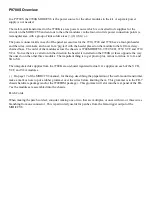
AV.io HD User Guide – How AV.io HD works
7
How AV.io HD works
Once you’re ready to start capturing, you’ll need either a built-in or third-party application to capture video
content with AV.io HD. The application will communicate with AV.io HD and negotiate a
frame rate
(frequency
at which frames in a video sequence are displayed) and
frame size
(size of a single video frame in pixels).
Resolutions and capture rates
The display resolution or display modes of a TV, computer monitor or display device is the number of distinct
pixels in each dimension that can be displayed.
AV.io HD generates a list of the following possible resolutions for your capture application to select for output
display:
640×360
848×480
1024×768
1280×1024
1920×1080
640×480
960×540
1280×720
1600×1200
1920×1200
Captured video content outputs to your application at
15, 30 or 60 frames per second
.
Aspect ratios
The aspect ratio of an image describes the proportional relationship between its pixel width and height.
AV.io HD outputs resolutions in many commonly supported aspects ratios, color-coded according to table of
resolutions above and described in the table below:
4:3
16:9
16:10 (8:5)
5:4
Aspect Ratio
Common Use
4:3
Standard letterbox TV display and non-widescreen computer displays
16:9
Widescreen (HD) TV displays (1080p, 1080i, 720p etc)
16:10 (8:5)
Widescreen computer displays
5:4
Sometimes used in larger format computer monitors











































